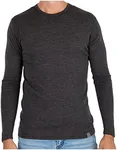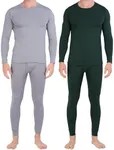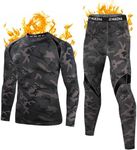Buying Guide for the Best Ski Base Layer
Choosing the right ski base layer is crucial for ensuring comfort, warmth, and performance on the slopes. A good base layer will help regulate your body temperature, wick away moisture, and provide a comfortable fit. When selecting a ski base layer, consider the material, fit, weight, and additional features to find the best option for your needs.MaterialThe material of a ski base layer is important because it affects warmth, moisture-wicking ability, and comfort. Common materials include merino wool, synthetic fabrics, and blends. Merino wool is excellent for warmth and odor resistance, making it ideal for cold conditions. Synthetic fabrics, like polyester, are great for moisture-wicking and quick drying, suitable for high-intensity activities. Blends offer a balance of both. Choose a material based on your activity level and the weather conditions you'll be skiing in.
FitThe fit of a base layer is crucial for comfort and performance. A snug fit ensures that the layer can effectively wick moisture away from your skin and provide insulation. Base layers typically come in three fits: compression, fitted, and relaxed. Compression fits are tight and support muscle performance, ideal for high-intensity skiing. Fitted base layers are snug but not tight, offering a balance of comfort and performance. Relaxed fits are looser and more comfortable for casual skiing. Choose a fit based on your comfort preference and activity level.
WeightThe weight of a base layer determines its warmth and suitability for different conditions. Base layers are categorized into lightweight, midweight, and heavyweight. Lightweight base layers are thin and best for mild conditions or high-intensity activities where you generate a lot of body heat. Midweight base layers offer more warmth and are versatile for a range of conditions. Heavyweight base layers provide maximum warmth for very cold conditions or low-intensity activities. Select the weight based on the weather conditions and your activity level.
Moisture-WickingMoisture-wicking is the ability of the base layer to draw sweat away from your skin and keep you dry. This is important for maintaining comfort and preventing chills. Materials like merino wool and synthetic fabrics are known for their moisture-wicking properties. When choosing a base layer, look for descriptions that highlight moisture-wicking capabilities, especially if you plan to engage in high-intensity skiing or expect to sweat a lot.
Odor ResistanceOdor resistance is a feature that helps keep your base layer smelling fresh even after prolonged use. This is particularly important for multi-day ski trips or high-intensity activities. Merino wool naturally resists odors, while some synthetic fabrics are treated with antimicrobial treatments to prevent odor buildup. If you are concerned about odor, look for base layers that emphasize odor resistance.
Seam ConstructionSeam construction affects the comfort and durability of a base layer. Flatlock seams are designed to minimize chafing and irritation, making them ideal for active use. Seamless construction offers even greater comfort by eliminating seams altogether. When choosing a base layer, consider the type of seam construction, especially if you have sensitive skin or plan to wear the base layer for extended periods.























